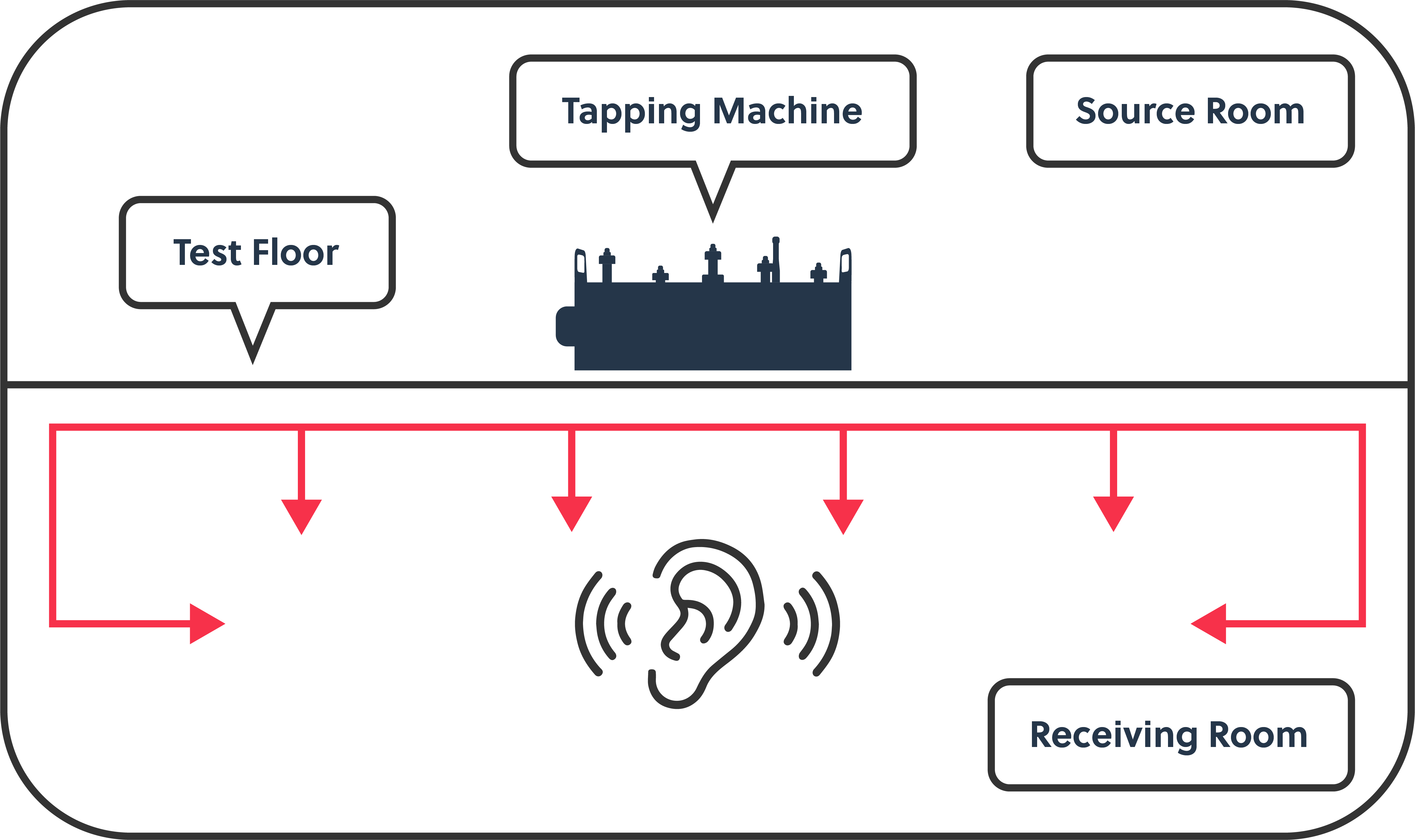Learn about impact acoustic ratings within Australian standards

Background to Impact Acoustics
In 2004, the Building Code of Australia (BCA) amended the minimum sound insulation requirements for multi-level dwellings to reflect community expectations. The BCA introduced a minimum impact sound insulation requirement for all floors. The term to describe the impact sound insulation of the floor is the “weighted normalised impact sound pressure level” (Ln,w) . The lower the Ln,w for the flooring assembly, the better the performance of the floor in terms of impact sound insulation.
Building Code of Australia (BCA) – AS ISO 717.2-2004 & BCA 2010 Spec F5.2
The BCA requires that the impact sound insulation of a floor is to be no more than 62 dB for floors separating dwellings or for floors separating dwellings from a plant room, lift shaft, stairway, public corridor, public lobby or the like, or parts of a different classification. These BCA/NCC requirements do not apply to Office, Education, Hospitality and other commercial buildings.
Information is needed for these results
It is very important to establish the below information as every building is different. What will pass on one may not pass on another. The below factors all come into play.
- Slab thicknesses / Density: This can differ from 150mm to 250mm and sometimes even thicker. Old builders use thinner slabs vs newer buildings are normally 200mm. Some competitors report test results on thick slabs, while test reports are done on a 150mm slab.
- Insulation thickness (if any): Is there insulation in the floor? What thickness is the ceiling
- Plasterboard thickness (if any): the modern apartments don’t even use it. What thickness is the ceiling plasterboard used?
- Ventilation space/ceiling space: This, again, can vary between buildings. What is the space between the ceiling and the concrete slab?
Also, ask what is or if the Body Corporate has an AAAC rating on the building, and what rating does our flooring need to achieve to meet this?
This is an important question to ask, along with the floor makeup. The correct information on the subfloor is the responsibility of the store and the unit owner.
We should always remember that all test results are site-specific and do not reflect an individual component's performance but the flooring system in that given location. A given test certificate will indicate performance, which may or may not be able to be duplicated at the client's location.
Association of Australian Acoustical Consultants (AAAC) Star Rating
The AAAC has introduced a rating system that ranks the acoustic quality within apartment buildings to fulfil a need identified by the community and the housing industry. The scheme uses a star rating system that defines acceptable levels of Ln, w within each rating. Body Corps normally set AAAC ratings in a building and are normally needed in a building already occupied. A new building will most of the time relate to the building code of = to or less than 62 DB.
What is the Stars DB amount for the AAAC?
2 Star acoustic rating – LnT,w < 65 dB
3 Star acoustic rating – LnT,w < 55 dB
4 Star acoustic rating – LnT,w < 50 dB
5 Star acoustic rating – LnT,w < 45 dB
6 Star acoustic rating – LnT,w < 40 dB
Why don’t we have a 6-Star flooring product?
To get a 6-star rating or any star rating, we need to know the makeup of the floor, i.e. the thickness of the slab, If it has and what the makeup of is of the plasterboard on the ceiling, the cavity, any fibrous insulation and the mounting system. On a normal unit, a 6-star rating with hard flooring can be almost impossible on most average units.
How do competitors say they have a 6-star rated flooring?
This is because they have tested it on an unrealistic subfloor. I have seen some products tested on a 350mm slab to get a good rating for marketing purposes.
What are the IIC test results?
Some Body Corps will ask for an IIC test result. The IIC test is a test used in Europe and America. This was the test used in Australia until 2004. With the IIC, the higher the Db rating, the better. We have these test results on our reports but are not recognised by the BCA or NCC.
What is Rw + Ctr, Airbourne sound, and how does it relate to flooring?
Airborne sound insulation measures the airborne sound reduction of flooring to the room below. Examples of airborne noise are sounds generated within a space, such as conversations, televisions and music.
The structural wall and floor construction mostly impacts the outcome of this measurement and, therefore, must be tested on-site, taking into account all building materials. Whilst the floor covering can affect the result, its impact is minimal, so floor products are not typically tested alone. The test method used for measurement is calculated in decibels using ISO 717.1 as Rw + Ctr. The higher the result, the better the acoustic performance, as it indicates a higher reduction in sound transfer.
How is the testing done?
Samples are installed prior to the test. It is required that samples must be >1m in length and 4 to 5 boards in width.
The first piece of equipment needed is the Tapping Machine – This is calibrated to a required standard of impact force (ISO717) This tapping machine simulates heavy footfall. It has 4 prongs that move simultaneously up and down on the sample, similar to pistons in a car. (earplugs required) @ a rate of 10 taps per second.
The tapping machine is turned on for 1-minute intervals and kept in the same location on the sample being tested.
After 1 minute, the tapping machine is then turned off. The location of the tapping machine on the sample is moved, and once ready machine is turned back on again. This is done 5 times per sample. This ensures a consistent and even reading across the different locations on the sample.
In the receiving room, the room directly below where the samples are installed. The 2nd acoustic engineer is situated with the sound receiver. This device picks up the noise level in this room in DB (transit noise).
While the tapping machine is on for that 1 minute, the engineer is swooping the below room with the receiver. Again, this ensures they get multiple readings and an average in-room noise result. This is also done across different frequencies.
This meter then calculates the average DB reading and shoots the data back to the Engineers laptop via Bluetooth. They can then do their analysis and provide us with the results.

Other Advice
Recommended Products
No matter what level of comfort and performance you need, Dunlop Springtred has it covered. There are 2 premium products available in the range, each offering a different level of comfort and support to suit your budget ...
Dunlop Carpetmate offers an extensive range of foam carpet underlays to help make your carpet even more comfortable. With eight different combinations of density and thickness available, you can choose the right ...